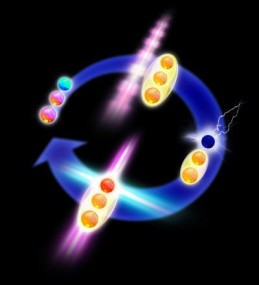Repetitive error correction in a quantum processor
May 27, 2011

A quantum bit (blue) is entangled with auxiliary qubits (red). If an error occurs, the state of the defective quantum bit is corrected (credit: Harald Ritsch)
A more efficient algorithm for error correction in quantum computers has been demonstrated experimentally by physicists at the Institute for Experimental Physics of the University of Innsbruck and the Institute for Quantum Optics and Quantum Information of the Austrian Academy of Sciences (IQOQI).
The physicists demonstrated the mechanism by storing three calcium ions in an ion trap. All three particles were used as quantum bits (qubits): one ion represented the system qubit while the other two ions represented auxiliary qubits. The system qubit was then entangled with the auxiliary qubits to transfer the quantum information to all three particles.
The physicists applied a quantum algorithm to determine whether an error occurred and, if there was an error, correct it. After making the correction, the auxiliary qubits were reset using a laser beam to enable repetitive error correction.
“For a quantum computer to become reality, we need a quantum processor with many quantum bits,” says Philipp Schindler. “Moreover, we need quantum operations that work nearly error-free. The third crucial element is an efficient error correction.”
Rainer Blatt, Philipp Schindler, et al., Experimental Repetitive Quantum Error Correction, Science, 27 May 2011: Vol. 332 no. 6033 pp. 1059-1061 DOI: 10.1126/science.1203329